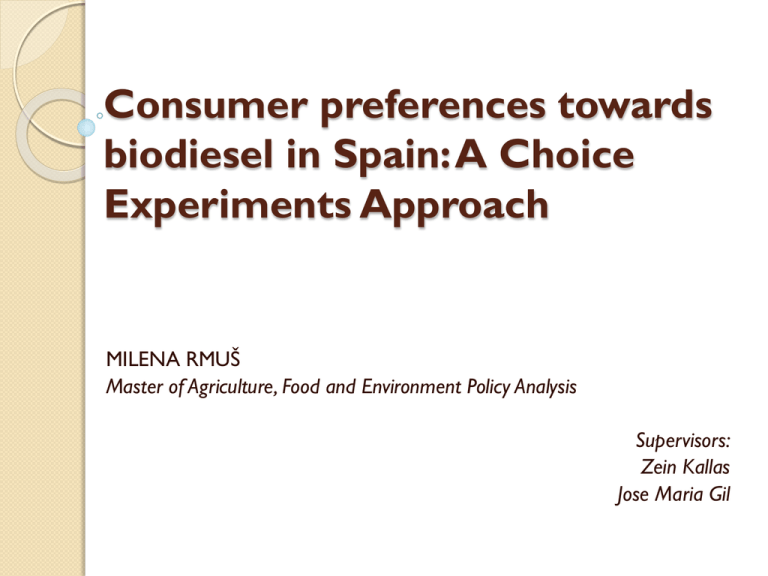Presentation
advertisement

Consumer preferences towards biodiesel in Spain: A Choice Experiments Approach MILENA RMUŠ Master of Agriculture, Food and Environment Policy Analysis Supervisors: Zein Kallas Jose Maria Gil Introduction Role of renewable energy sources Directive 2009/28/EC on the promotion of use of energy from renewable sources mandatory targets for MSs of 20% share of renewable energy in total energy consumption and 10% share of energy from renewable sources in all forms of transport by 2020. Energy context → Challenges of EU in transport sector (30% of energy consumption of which 98% is based on fossil fuels) → Biofuels as solution Background Reasons for public support for biofules: 1. To reduce greenhouse gas (GHG) emissions – complying with commitments laid down in Kyoto Protocol and to help climate change protection 2. To decrease dependence on foreign energy imports, since it has virtually no oil production and raw materials for production of biofuels can be produced within EU 3. To diversify energy sources 4. More stable fossil fuel prices since biofuels can replace them on market 5. To support rural development creating activities in rural area and creating demands for agricultural products thus providing additional source of income for the primary sector Spain is interesting for the topic of biofuels because it has high energy dependency, high consumption of fuel per unit of GDP and environmental problems associated with GHG emissions What are biofuels? EU defines biofuels as liquid or gaseous fuels for transport produced from biomass. They can be produced directly from plants and indirectly from industrial, commercial and agricultural waste Two main types of biofuels which are currently used commercially in transport and seen as fossil fuels substitutes: ethanol as substitute for gasoline and biodiesel as substitute for conventional diesel First and second generation biofuels Unintended impact s of biofuel `s technologies Policy framework for biofuels Main legislative in EU – Directive 2009/28/EC - proclaims development of NREAP at MSs levels Main legislative in Spain – Order of Ministry of Industry, Tourism and Commerce ITC/2877/2008 Royal Decree 459/2011 – establishes minimum mandatory annual targets for sale and consumption of biofuels for transport: The minimum amount of certificates of biofuels The minimum amount of biofuels in diesel certificates The minimum amount of biofuels in gasoline certificates 2011 6.2% 2011 6% 2011 3.9% 2012 6.5% 2012 7% 2012 4.1% 2013 6.5% 2013 7% 2013 4.1% Policy framework for biofuels According to Spanish NREAP targets for renewable energy sources as a percentage of final consumption in transport sector are: Year Target (%) 2011 2012 2013 2014 2015 2016 2017 2018 2019 2020 6.1 6.5 6.5 8.2 9.3 10.4 11.1 12.0 12.7 13.6 Measures to support production and consumption of biofuels: a) Budgetary support (direct support for biomass supply and tax exceptions) b) Consumption targets – blending or use targets (mandates), which impose a minimum market share for biofuels in total fuel sales c) Trade measures such as import tariffs d) Efficiency-enhancing measures Objective of the study The main objective of the thesis is to estimate consumers’ willingness to pay for biodiesel and analyze reasons behind their purchasing decisions of fuel for their cars. In order to estimate consumer preferences, the Choice Experiments (CE) technique has been employed using the data obtained from the survey conducted in the province of Barcelona (Spain). Additionally, we analyze consumer’s general knowledge on biofuels, environmental attitudes and opinions on ongoing issues attached to the usage of biodiesel. More specifically, we aim to test in this study the following aspects: 1. How much consumers are willing to pay for the biodiesel 2. Effect of socio-economic features of the sample towards their willingness to pay. 3. Other factors that influence WTP such as environmental awareness and general knowledge on biofuels 4. Possible trade-off that respondents would made if biodiesel may affect price of other raw materials such as cereals and consequently the price of bread Research methodology Choice Experiments are stated preference method to assess the value of non-market goods or newly introduced products on the market by using individuals’ stated behavior in a hypothetical setting. CE is one of the most frequently used methods in the estimation of individual preferences. It implies the choice of the most preferred option relative to other options. The aim is to see how people respond to a range of choices and determine their willingness to pay for a certain good or service as they are presented with real life choices. Biodiesel is used on voluntarily decisions of the consumers since it is just an available option on the market of fuels. Analyzing the consumer preferences and perception on biofuels is essential when designing the national policies to encourage the consumption of biodiesel and achieving targets stated in RED. Theoretical framework The theoretical foundation of CE method lies in Lancaster’s theory of value (Lancaster, 1966) and in Random Utility Theory. Within the Random Utility Theory framework (Thurstone, 1927; McFadden, 1973) the indirect utility function for each respondent can be expressed as: Suppose that individual i chooses alternative g from the choice set C. If the rational behavior is assumed the respondent will choose alternative g in preference to j if Uig>Uij . Hence, the probability that any respondent prefers option g in a choice set to any alternative option j can be written as: Different assumptions made about the distribution of the random component leads to different model forms. For instance, if the random components are assumed to follow an independent and identically distributed (IID) Type I extreme value distribution, then the probability of choosing option g takes the following form of a multinomial logit model: Theoretical framework Equation can be estimated by means of a multinomial logit regression which assumes that choices are consistent with the independence of irrelevant alternatives (IIA) property. This property requires that the probability of an option being chosen should be unaffected by the inclusion or omission of other alternative options. If a violation of the IIA assumption is found, then other model variants (e.g. Multinomial Probit, Nested Logit and Random Parameter Logit) can be employed to relax IIA property. Survey design Structure of the questionnaire According to Hanley et al. (2001) the CE exercise has been defined as consisting of following stages: 1. Selection of attributes 2. Assignment of levels 3. Choice of experimental design 4. Construction of choice set 5. Measurement of preferences 6. Estimation procedure Attributes and levels Attribute Type of diesel Levels Normal diesel; biodiesel 10% mixture; biodiesel 20% mixture; biodiesel 30% mixture Location of the petrol The usual route; outside usual route station Type of the petrol Small petrol stations; large multinational petrol stations station Price of bread Unchanged; increases 5%; increases 10%; increases 20% Experimental design and sample The forced choice was use in the construction of the choice set which does not include a opt-out option (null option or outside option) and forces participants to choose from a set of alternatives Dual Response Choice Experiment Design The choice sets were created using orthogonal design created with SPSS 19.0 which resulted in 24 choice cards which were divided into 3 combinations of choice cards thus each containing 8 choice cards. The first combination of the cards (A) did not contain price of bread as an attribute while two other combinations of the cards (B and C) contained all 4 attributes. Experimental design and sample OPTION A Biodiesel 20% mixture Small local petrol stations Outside usual route Price of bread increases 10% OPTION A OPTION B Biodiesel 10% mixture Large multinational petrol stations At usual route Price of bread increases 5% OPTION B 1. If the options A and B are the only one available, which one would you choose? 2. If you could choose any of the two previous options which one would choose? OPTION A OPTION B NONE If answering A or B in the second question and given that the average price for DIESEL in Catalonia in the last month was 1.26 € / liter, how much are you willing to pay for a liter of fuel for your selected option above:____________€/liter Analysis and discussion – Descriptive statistics Sample characteristics - 300 car owners/users over 18 years of age that regularly purchase fuels. Most of the respondents were male (72, 33%) with an age between 30 and 44 and living in households of 3 or 4 people. More than a half of participants had university level studies and were employees with income between 1000 and 2500€ per month. Consumption of biodiesel among the sample is low with only 1% of respondents using biodiesel always and 16 % using it occasionally. Stated reasons for not using biodiesel were mostly that it is not recommended by car manufacturer and that they actually haven't decided whether to use it or not. When purchasing fuels the most important attribute is price of the fuel Knowledge on biodiesel – almost all respondents are familiar with existence of biodiesel, however they have low level of knowledge regarding the raw materials for its production and mixtures of biodiesel that are available on the market Most of the respondents believe that biofuels may raise the food prices and that agricultural land should be use for its production Analysis and discussion – Descriptive statistics Set of attitudinal questions were employed in the questionnaire in order to examine respondents attitudes towards ongoing issues connected to the use of biofuels. 1. Impact of the factors on rising food prices – most significant factor are speculations on in the global market and political reasons 2. Level of respect that energy sources place on the environment – solar and wind energy have highest level of respect while fossil fuels are least environmentally friendly 3. Transport alternatives if prices of fuel continue to rise – public transport, hybrid car, driving less, bicycle Analysis and discussion – Descriptive statistics 4. Agreement to the statement Level of agreement (%) Biodiesel is less polluting than conventional diesel The production of biodiesel will make us less dependent on fossil fuels Biofuel production is major cause of rising prices for some food commodities I would accept an increase in food prices in exchange for a reduction of fuel prices in the same proportion When using biodiesel I believe there is no differences in the consumption of my car comparing to conventional diesel Performance (number of kilometers traveled) of biodiesel is higher than that of conventional diesel 9 10 N/A 8 20.33 1.67 8.67 15.33 1.33 10 8 2.33 5 2.33 2 1 4.67 8.67 5.67 5.67 5.67 2 3.33 1 2.67 8 7 8 0 1 2 3 4 5 6 3.67 2 1.67 0.67 1.33 22.33 7.33 14.67 16.33 2.67 1 2.33 3.33 2.33 23 9.67 17.33 2 0.67 4.33 3.67 4.33 30.33 7 17 7 3.67 17 3.33 4.33 3.33 2 1.33 3 3 51.33 5.67 7.67 2.67 5.33 3.33 4 57 3 13 24.67 10.67 14.67 14.67 Analysis and discussion - CE Results 50% of the respondents choose to answer the combination of the choice cards A while 24.67% choose B and 25.33% choose C. Two specifications for the analysis of the data: Conditional Logit (CL) and Random Parameter Logit (RPL) model using NLOGIT 4.0 as software Estimation of 2 models: basic and hybrid model CE results of basic model β (mean value) Multinational petrol stations Outside usual route Biodiesel 10% Biodiesel 20% Biodiesel 30% Price of bread increases 5% Price of bread increases 10% Price of bread increases 20% Log-L R-sqrd R2adj Chi-sqrd AIC/N N β (mean value) Small local petrol stations On usual route Conventional diesel Price of bread unchanged CL model GROUP 1 GROUP 2 - 0.15525*** - 0.07826* - 0.27396*** - 0.63964*** -0.28896 -0.11597 0.09662 -0.35575*** 0.07366 0.09690 0.02120 - 0.30999*** -0.84500*** - -1250.2778 0.0950 0.0920 51,7565 [8] 1.925 1184 -1280.2778 0.1250 0.1231 36.6223 [5] 1.928 1168 CL model GROUP 1 GROUP 2 0.15525*** 0.07826* 0.27396*** 0.63964*** 0.11868 0.56863*** 1.13379*** - RPL model GROUP 1 GROUP 2 - 0.17120*** - 0.00680 - 0.29934*** - 1.01657*** -0.29085*** -0.12417 0.09762 0.41763*** 0.08869 -0.25868* 0.02701 -0.35262*** 0.934439*** S.D of random β 0.01006 0.55333*** 0.04671 0.85103*** 0.21506 0.26137 0.57124*** 0.92171*** 0.20491 1.38230*** 0.01725 0.39592*** 0.44285*** -1300.7569 -1283.1792 0.1380 0.2096 0.1321 0.2062 1.921 1.754 1184 1168 RPL model GROUP 1 GROUP 2 0.17120*** 0.00680 0.29934*** 1.01657*** 0.10454 0.80049*** 1.26000*** - CE results of basic model Relative importance of all attributes – ratio of a particular attribute`s utility to the sum of all attribute`s utility: Ok m ax u k m in u k K m ax u k m in u k k 1 Attribute Type of petrol station Location of petrol station Type of diesel Price of bread CL model GROUP 1 GROUP 2 9,57%*** 6,63%** 16,89%*** 54,2%*** 12,56%*** 39,16%*** 60,98%*** - RPL model GROUP 1 GROUP 2 9,7%*** 0,42% 16,96%*** 62,27%*** 11,2%*** 37,31%*** 62,15%*** - WTP PROCEDURE For the purpose of calculating WTP we employed the following steps: 1. RPL results are used since the model showed to be a better fit and because we were able to obtain the individual estimates. 2. We calculate the relative importance for each attribute and for each individual of the sample. 3. The WTP for each attribute is calculated taking into consideration respondent WTP as an average of the valuation of the 8 cards he/she answered. 4. In the fourth step we calculated the range of utility/disutility for the levels valued positively or negatively for each attribute. 5. In the fifth step, the WTP for each attribute calculated in the third step is assigned for the positively valued levels taking into consideration their relative importance. For the negatively valued levels, an equal value of the WTP (but in negative term) is assigned to them taking into consideration their relative importance. 6. Finally, the WTP for each attributes and levels is obtained. Thus, WTP for every level of each attribute is calculates as: relative importance of level of the attribute x WTP of the attribute CE results of basic model - WTP WTP average (€) Type of diesel Normal diesel Biodiesel 10% Biodiesel 20% Biodiesel 30% Location of petrol station On usual route Outside usual route Type of petrol station Small petrol stations Large multinational petrol stations Price of bread Unchanged Increases 5% Increases 10% Increases 20% Average WTP of the sample GROUP 1 GROUP 2 0.110 -0.147 0.095 0.050 0.493 -0.085 -0.213 -0.289 0.171 -0.171 0.126 -0.126 0.097 -0.097 -0.5 0.5 0.613 0.014 -0.158 -0.471 1.10 1.17 CE results of hybrid model TYPE LOCAL PETROL STATIONS GROUP 1 VARIABLES MULTINATIONAL PETROL STATIONS GROUP 2 GROUP 1 GROUP 2 Male Female Male Female Male Female Male Female 0.17** 0.12* 0.06** 0.12* -0.17** -0.12* -0.06** -0.12* BCN Other BCN Other BCN Other BCN Other 0.08* 0.21* 0.04* 0.12* -0.08* -0.21* -0.04* -0.12* Gender Residence 18-29 30-59 >60 18-29 30-59 >60 18-29 30-59 >60 18-29 30-59 >60 0.04* 0.18* 0.21 0.04* 0.10* -0.09 -0.04* -0.18* -0.21 -0.04* -0.10* 0.09 0-2 3 4-6 0-2 3 4-6 0-2 3 4-6 0-2 3 4-6 0.11* 0.14* 0.21* 0.08* -0.01* 0.09 -0.11* -0.14* -0.21* -0.08* 0.01* -0.09 Age Family members Primary Secondary University Primary Secondary University Primary Secondary University Primary Secondary University Educational level 0.26 0.17* 0.12* 0.17 -0.02* 0.12* -0.26 -0.17* -0.12* -0.17 0.02* -0.12* Employment Student Employed Retired Student Employed Retired Student Employed Retired Student Employed Retired situation 0.03 0.16* 0.14 0.11 0.09* -0.11 -0.03 -0.16* -0.14 -0.11 -0.09* 0.11 <1000 1000-2500 >2500 <1000 1000-2500 >2500 <1000 1000-2500 >2500 <1000 1000-2500 >2500 0.17 0.13* 0.22* 0.11 0.09* 0.02* -0.17 -0.13* -0.22* -0.11 -0.09* -0.02* Income level CE results of hybrid model LOCATION OUTSIDE USUAL ROUTE ON THE USUAL ROUTE GROUP 2 GROUP 1 GROUP 2 GROUP 1 VARIABLES Male Female Male Female Male Female Male Female 0.27** 0.33** 0.59** 0.78* -0.27* -0.33* -0.59** -0.78* BCN Other BCN Other BCN Other BCN Other 0.39* 0.19* 0.74* 0.53* -0.39* -0.19* -0.74* -0.53* Gender Residence 18-29 30-59 >60 18-29 30-59 >60 18-29 30-59 >60 18-29 30-59 >60 0.19* 0.31* 0.23 0.79* 0.63* 0.39 -0.19* -0.31* -0.23 -0.79* -0.63* -0.39 0-2 3 4-6 0-2 3 4-6 0-2 3 4-6 0-2 3 4-6 0.18* 0.35* 0.33* 0.58* 0.84* 0.65 -0.18* -0.35* -0.33* -0.58* -0.84* -0.65 Age Family members Primary Secondary University Primary Secondary University Primary Secondary University Primary Secondary University Educational level 0.37 0.28* 0.25* 1.00 0.59* 0.63* -0.37 -0.28* -0.25* -1.00 -0.59* -0.63* Employment Student Employed Retired Student Employed Retired Student Employed Retired Student Employed Retired situation 0.49 0.27* 0.21 0.67 0.67* 0.39 -0.49 -0.27* -0.21 -0.67 -0.67* -0.39 <1000 1000-2500 >2500 <1000 1000-2500 >2500 <1000 1000-2500 >2500 <1000 1000-2500 >2500 0.19* 0.25* 0.43* 0.75 0.57* 0.81* -0.19* -0.25* -0.43* -0.75 0.57* -0.81* Income level CE results of hybrid model FUEL CONVENTIONAL DIESEL GROUP 1 VAR BIODIESEL MIXTURE 10% GROUP 2 GROUP 1 BIODIESEL MIXTURE 20% GROUP 2 GROUP 1 BIODIESEL MIXTURE 30% GROUP 2 GROUP 1 GROUP 2 Male Female Male Female Male Female Male Female Male Female Male Female Male Female Male Female 0.16* -0.02 0.58* -0.02 0.23* -0.51 -0.11* -0.51 0.01 0.35 -0.38* 0.35 0.06* 0.18 -0.09* 0.18 BCN Other BCN Other BCN Other BCN Other BCN Other BCN Other BCN Other BCN Other 0.18 0.09 0.60 0.54 -0.23 -0.35 -0.14 -0.09 0.08 0.10 -0.34 -0.37 -0.03 0.16* -0.12 -0.07 Gender Residence 18-29 30-59 >60 18-29 30-59 >60 18-29 30-59 >60 18-29 30-59 0.18 0.10 0.13 0.91 0.36* 1.35 -0.36 -0.24 -0.46 -0.23 -0.04* -0.40 Family 0-2 3 4-6 0-2 3 4-6 0-2 3 4-6 0-2 3 members 0.00 0.36 0.10 0.49 1.00 0.50 -0.28 -0.24 -0.35 -0.06 Educat. Prim Sec Uni Prim Sec Uni Prim Sec Uni level -0.03 0.05 0.20 0.08 0.80 -0.35 -0.15 -0.18 Employ. Stud Empl Retired Stud Empl Retired Stud situation -0.13 0.15* 0.40* Income <1000 10-2500 >2500 <1000 10-2500 >2500 <1000 10-2500 >2500 <1000 10-2500 >2500 <1000 10-2500 >2500 <1000 10-2500 >2500 <1000 10-2500 >2500 <1000 10-2500 >2500 >60 18-29 30-59 >60 18-29 30-59 >60 18-29 30-59 >60 18-29 30-59 0.08 0.10 0.09 -0.54 -0.23 -0.87 0.10 0.03* 0.23 -0.15 -0.09* -0.07 4-6 0-2 3 4-6 0-2 3 4-6 0-2 3 4-6 0-2 3 4-6 -0.29 -0.10 0.10 0.10 0.09 -0.26 -0.42 -0.40 0.17 -0.22 0.16 -0.17 -0.29 0.03 Prim Sec Uni Prim Sec Uni Prim Sec Uni Prim Sec Uni Prim Sec Uni -0.38 -0.14 -0.14 -0.10 0.21 0.15 0.02 -0.09 -0.52 -0.30 -0.04 -0.02 0.15 0.15 -0.14 -0.10 Empl Retire Stud Empl Retired Stud Empl Retir Stud Empl Retir Stud Empl Retire Stud Empl Retired -0.63 -0.27* -0.74 0.32 0.02* -0.24 -0.08* -0.07 >60 Age level 0.29 0.02 0.02 0.25 1.02 0.29 0.36* 1.39 1.41 -0.48 -0.26* -0.42 -0.42 -0.24 -0.33 -0.15 -0.05* -0.57 -0.42 -0.02 -0.21 -0.48 -0.26* -0.42 0.04 0.19 -0.12 0.04 -0.27 -0.27 0.09 0.02* 0.35 0.20 0.09 -0.07 -0.08 CE results of hybrid model BREAD UNCHANGED INCREASES 5% INCREASES 10% INCREASES 20% GROUP 1 GROUP 1 GROUP 1 GROUP 1 VARIABLE Male Female Male Female Male Female Male Female 1.05* 1.43 0.07* -0.11 -0.25* -0.52 -0.86 -0.80 BCN Other BCN Other BCN Other BCN Other 1.09 1.19 -0.2 0.06 -0.23 -0.38 -0.84 -0.87 Gender Residence 18-29 30-59 >60 18-29 30-59 >60 18-29 30-59 >60 18-29 30-59 >60 0.97 1.18* 1.16 0.16 0.01* -0.14 -0.35 -0.27* -0.44 -0.77 -0.92 -0.59 0-2 3 4-6 0-2 3 4-6 0-2 3 4-6 0-2 3 4-6 1.21 1.25 1.00 -0.04 0.10 0.04 -0.44 -0.40 -0.11 -0.72 -0.96 -0.93 Age Family members Education level Employment situation Primary Secondary University Primary Secondary University Primary Secondary University Primary Secondary University 1.69 1.08 Student Employed 1.07 Retired -0.29 -0.01 Student Employed 0.11 Retired -0.49 -0.35 Student Employed -0.24 Retired -0.91 -0.72 Student Employed -0.94 Retired 1.12 1.12* 1.28 -0.07 0.03* -0.02 -0.26 -0.28* -0.52 -0.79 -0.87 -0.74 <1000 1000-2500 >2500 <1000 1000-2500 >2500 <1000 1000-2500 >2500 <1000 1000-2500 >2500 1.33 1.16* 0.92 0.00 -0.01* 0.09 -0.45 -0.32* -0.16 -0.89 -0.83 -0.85 Income level CE results of hybrid model - WTP GROUP 1 Gender Residence GROUP 2 Male Female Male Female 1.09 1.13 1.17 1.19 BCN Other BCN Other 1.18 1.04 1.12 1.19 18-29 30-59 >60 18-29 30-59 >60 0.99 1.13 1.08 1.13 1.21 1.18 0-2 3 4-6 0-2 3 4-6 1.08 1.11 1.10 1.19 1.11 1.22 Primary Secondary University Primary Secondary University 1.08 1.04 1.16 1.17 1.15 1.19 Employment Student Employed Retired Student Employed Retired situation 1.11 1.12 0.99 1.12 1.19 1.10 <1000 10-2500 >2500 <1000 10-2500 >2500 0.93 1.10 1.15 1.09 1.18 1.19 Age Family members Educational level Income level Conclusions Biodiesel will penetrate in the higher volume if it is available on large number of petrol stations Respondents in the survey prefer to buy conventional diesel compared to biodiesel mixtures → reasons Price of bread is most significant attribute for the respondents ; respondents strongly prefer that the price of bread remains unchanged and they are not willing to accept the increase in food prices for the decrease in price of fuels in same proportion Most preferred combination for the respondents will be to purchase conventional diesel on the local petrol stations on their usual routes while the price of bread remains the same Consumers are willing to buy biodiesel only if there is a discount in price Average WTP for the sample is below the market price Generally positive attitudes towards biodiesel but extremely low level of usage among the sample and generally low level of knowledge – raising awareness of consumers Ambitious Spanish target for 2020? THANK YOU FOR YOUR ATTENTION!








